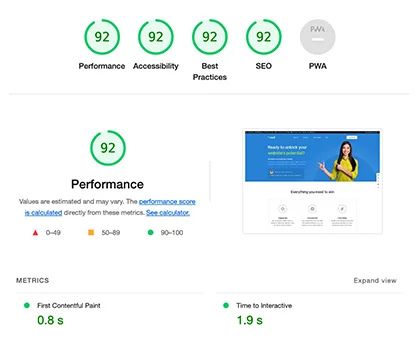SEO (Search Engine Optimization) is the process of creating your website’s content, technical aspects, and link profile to rank higher on search engines like Google and Bing. Basically, SEO is a strategy that helps your site rank higher in “organic” (i.e., unpaid) search results.
Many people think that once SEO is set up correctly, that’s it—“One-time SEO setup is enough.” But this notion is completely wrong. Search engines regularly update their algorithms, with Google making hundreds of changes annually.
In addition:
Competition is always there—if you stagnate, your competitors can overtake you.
User behavior and trends keep changing—phrases that drive traffic today may not tomorrow.
So, SEO is a never-ending process—it’s a journey that needs to be constantly monitored, updated, and improved.
What is Ongoing SEO?
Ongoing SEO, also known as continuous or sustainable SEO, is the process of constantly monitoring, updating, and improving a website’s SEO. It ensures that your site stays optimized for changing search engine algorithms, user behavior, and market trends.
One-time SEO vs. Ongoing SEO
One-time SEO bootstraps your site, but ongoing SEO keeps it running like an industrial machine — it will stop if you don’t keep it running.
| Aspect | One‑time SEO | Ongoing SEO |
|---|---|---|
| Definition | A single, comprehensive optimization session keyword research, on-page fixes, technical setup typically done at launch. | A continuous process of monitoring, updating, and improving SEO elements like content, links, and tech aspects |
| Duration & Scope | Limited in time one pass, then move on | Long-term, regular updates, audits, refreshes, and adaptations to changes |
| Adaptability | Cannot react to algorithm changes, shifting trends, or competitors | Flexible and responsive includes monitoring algorithm updates, competitor moves, and user behavior |
| Content Strategy | Initial content optimized once | New content creation and periodic updates to keep pages fresh and relevant |
| Backlink & Authority | Initial link-building effort | Ongoing backlink acquisition and cleanup to maintain domain authority |
| Technical Maintenance | Initial resolve of errors, mobile setup, site structure setup | Regular audits to catch speed issues, broken links, mobile and schema problems |
| Reporting & Analysis | Often lacks ongoing performance tracking | Continuous monitoring of rankings, traffic, conversions using analytics tools |
| Analogy (Fitness) | Like doing a workout once and expecting lifelong fitness | Like following a regular fitness routine workouts, nutrition, rest to stay fit long-term |
Key Components of Ongoing SEO
Content Updates and Optimization
Refresh old blog posts: Review your old articles every few months, updating their data, links, and information. This signals Google that your site is active and improving significantly.
Add new content: Write fresh, useful articles based on new trends or emerging keywords. This helps you reach new audiences.
Technical SEO Monitoring
Fix crawl errors: Find and fix 404 errors and indexing issues in a timely manner with tools like Google Search Console.
Improve site speed and mobile-friendliness: Ensure site load speed, WebP/AVIF images, lazy loading, and responsive design with tools like PageSpeed Insights, Lighthouse.
Technical SEO Monitoring
Fix crawl errors: Find and fix 404 errors and indexing issues in a timely manner with tools like Google Search Console.
Improve site speed and mobile-friendliness: Ensure site load speed, WebP/AVIF images, lazy loading, and responsive design with tools like PageSpeed Insights, Lighthouse.
Backlink Building and Cleanup
Build high-quality backlinks regularly: Getting links from reputable sites maintains your site’s authority, remember that promoting new articles is important.
Remove toxic backlinks: Check the backlinks profile from time to time and delete or disavow sites that are spammy.
Competitor Analysis
Check competitors’ SEO strategy: What keywords and content are they targeting? Improve your strategy based on that.
Adjust according to the changing landscape: If a competitor is leading in new features or trends, then you should incorporate it in your site.
User Experience (UX) Improvements
Monitor bounce rate, dwell time, and user behavior: Track these metrics—if the bounce rate is high, UX needs improvement.
Make design or navigation tweaks: Simple and clear UI/UX will lead to a better user experience, which will benefit both engagement and SEO.
Core Web Vitals and Google Algorithm Updates
Focus on Core Web Vitals: Periodically test and improve metrics like LCP (≤2.5 seconds), FID (<100ms), CLS (<0.1).
Make appropriate changes after algorithm updates: Google has prioritized mobile-first indexing and advanced schema, security features like HTTPS.
Why Ongoing SEO is Important
Search Engines are constantly updating.
Google and other search engines change multiple times a year (500–600 updates per year according to some reports). The strategy that works today may not work tomorrow. Ongoing SEO ensures that your website is always in line with the latest algorithms and best practices, so that the rankings do not drop.
Competitors are constantly optimizing
The competition in the digital world is fierce. If you stop SEO, your rank may fall as your competitors will be regularly updating their content and technical aspects.
Customer Behavior and Search Trends keep changing
People are searching for something new every day, shifting from corona trends to voice search. Ongoing SEO keeps your content strategy in line with changing user behavior and new keyword trends.
Ensures long-term rankings
A one-time SEO boost is important, but continuous SEO is essential for stable, consistent rankings because:
- Regular analysis identifies improvements
- Keeping your content updated keeps it fresh and relevant
- Technical issues can be caught and resolved quickly
All of this adds up to consistency in your website’s visibility and traffic.


